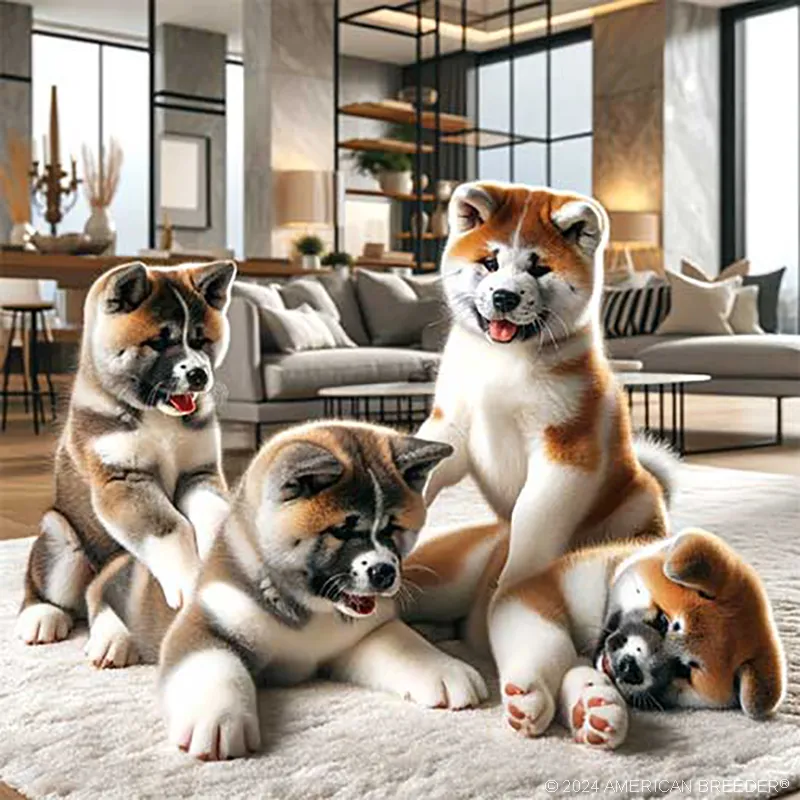The Comprehensive Guide to the Japanese Akitainu Dog
 In the enchanting world of canine companions, the Japanese Akitainu Dog stands as a regal and intriguing figure, deeply rooted in history and brimming with unique qualities. With origins tracing back to the rugged landscapes of Japan, this breed embodies a blend of strength, loyalty, and independence that has captivated dog enthusiasts worldwide. This guide delves into every facet of the Japanese Akitainu Dog, unraveling its historical journey, intricate physical attributes, intricate temperament, health considerations, training needs, and the special place it holds in the hearts of its admirers.
In the enchanting world of canine companions, the Japanese Akitainu Dog stands as a regal and intriguing figure, deeply rooted in history and brimming with unique qualities. With origins tracing back to the rugged landscapes of Japan, this breed embodies a blend of strength, loyalty, and independence that has captivated dog enthusiasts worldwide. This guide delves into every facet of the Japanese Akitainu Dog, unraveling its historical journey, intricate physical attributes, intricate temperament, health considerations, training needs, and the special place it holds in the hearts of its admirers.
Glimpse into History
The narrative of the Japanese Akitainu Dog is a tale woven through time, echoing the echoes of ancient Japan. Originating in the Akita Prefecture, these dogs were initially bred for a practical and daring purpose - to hunt formidable game such as bears, boars, and deer.
Their robust build, innate courage, and unwavering loyalty made them ideal hunting companions. Over centuries, the Akitainu's role evolved, encompassing the duty of guarding, preserving the homes of Japanese families. Yet, their journey hasn't been without trials, including their near-extinction during World War II, a chapter that speaks to their resilience and the dedication of breed enthusiasts who worked tirelessly to safeguard their legacy.
Unveiling the Physical Charisma
The Japanese Akitainu Dog boasts an appearance that's both captivating and emblematic. Their physique commands attention:
Size: Majestic and sturdy, males stand at 26 to 28 inches (66 to 71 cm), and females exhibit a slightly smaller stature.
Weight: The Akitainu's weight ranges from 70 to 130 pounds (32 to 59 kg), exhibiting the power and endurance that befits their heritage.
Coat: Wrapped in a luxurious double coat, their dense undercoat offers insulation against the elements, while the outer coat, characterized by its harsh texture, forms a protective shield.
 Colors & Patterns: The Akitainu's coat palette is a canvas of diversity, encompassing hues of pure white, deep red, striking sesame (a mix of red and black-tipped hairs), captivating brindle patterns, and the striking pinto (patches of color amidst a white backdrop).
Colors & Patterns: The Akitainu's coat palette is a canvas of diversity, encompassing hues of pure white, deep red, striking sesame (a mix of red and black-tipped hairs), captivating brindle patterns, and the striking pinto (patches of color amidst a white backdrop).
Distinctive Features: Among the most iconic traits is the curled tail that rests gracefully over their back, exuding an air of dignity and poise.
The Soul of the Akitainu
Stepping into the realm of the Japanese Akitainu's temperament and personality is akin to embarking on a journey of discovery, where loyalty, independence, and elegance entwine:
Loyalty: In the heart of the Akitainu beats an unwavering loyalty to its family, a trait rooted in its history as a protector and companion.
Independence: These dogs possess a sense of independence that's emblematic of their history as self-reliant hunters. This quality often translates to a calm and composed demeanor.
Dignified Presence: The Akitainu carries itself with an innate sense of dignity, a quality that's impossible to ignore. It's a breed that stands tall in both physicality and character.
Social Dynamics: While reserved with strangers, Akitainus forge strong bonds with their families. Proper socialization from a young age helps them coexist harmoniously with other pets and people.
Moderate Energy: Akitainus strike a balance between playfulness and serenity, making them adaptable to both active play and lounging.
 The Path to Optimal Care
The Path to Optimal Care
Ensuring the well-being of your Japanese Akitainu encompasses a spectrum of considerations, each contributing to their health and happiness:
Health Considerations: While generally robust, Akitainus can be prone to conditions like hip dysplasia, progressive retinal atrophy (PRA), and hypothyroidism. Regular veterinary check-ups and a balanced diet are essential.
Grooming Rituals: The Akitainu's double coat demands regular grooming to prevent tangling and manage shedding. Brushing a few times a week and occasional baths suffice to maintain their coat's luster.
Fitness and Activity: Balancing their independent nature with their need for exercise is crucial. Daily walks and mental stimulation through puzzle toys and interactive games cater to their physical and intellectual well-being.
Nurturing the Akitainu Spirit
Training and socialization form the cornerstone of nurturing a well-rounded and harmonious Akitainu companion:
Training Approach: The Akitainu thrives under positive reinforcement methods that encompass treats, praise, and patience. Begin training early to shape their behavior effectively.
Early Socialization: Exposing them to various environments, people, and animals during their formative months fosters a confident and well-mannered dog.
Obedience and Leadership: Establishing yourself as a consistent and calm leader is vital. Akitainus may challenge authority, but with firm and fair guidance, they become obedient companions.
 Becoming a Keeper of the Akitainu Flame
Becoming a Keeper of the Akitainu Flame
Embracing life with a Japanese Akitainu Dog is a commitment that intertwines companionship with responsibility:
Living Arrangements: While adaptable to various environments, Akitainus thrive in homes with space to move, making houses and rural settings favorable choices.
Financial Planning: Beyond the initial cost, prepare for ongoing expenses including quality food, routine veterinary care, grooming supplies, and unexpected medical needs.
Breeding Considerations: Breeding Akitainus requires a deep understanding of genetics, health considerations, and responsible breeding practices to preserve the breed's integrity.
The Enduring Legacy
The Japanese Akitainu Dog transcends time and borders, etching its mark on history as a loyal companion, a guardian, and a symbol of the enduring bond between humans and dogs. This comprehensive guide provides a glimpse into the world of this majestic breed, inviting enthusiasts to explore its history, understand its temperament, and embrace the joys and responsibilities of sharing life with a Japanese Akitainu. As you embark on this journey, remember that each Akitainu is a living testament to the remarkable relationship between canines and humankind.
Japanese Akitainu Dog Quick Reference Guide
 Breed Background: Origin: Japan | Breed Purpose: Hunting and guarding | AKC Class: Working | Year Recognized by AKC: 1972
Breed Background: Origin: Japan | Breed Purpose: Hunting and guarding | AKC Class: Working | Year Recognized by AKC: 1972
Appearance: Size: Large | Weight: 70-130 lbs | Coat Type: Double coat | Colors & Patterns: Various (white, red, sesame, brindle) | Distinctive Features: Curled tail, dignified demeanor
Temperament: Energy Level: Moderate | Loyalty: High | Friendliness to Pets: Moderate | Friendliness to Strangers: Reserved | Trainability: Moderate | Playfulness: Moderate | Frequent Barker: Low | Chase Instincts: Moderate | Sense of Smell: Moderate | Drive to Hunt: Moderate
Health & Care: Health Issues: Hip dysplasia, PRA, hypothyroidism | Lifespan: 10-15 years | Grooming Difficulty: Moderate | Exercise Needs: Moderate to high
Socialization: Interaction with Children: Generally good | Interaction with Pets: Variable, early socialization helps | Interaction with Strangers: Reserved | Elderly Compatibility: Can be gentle | Ease of Training: Moderate
Suitable Living Arrangements: Apartment: Not ideal | House: Yes | Rural Area: Preferred | Yard Size Requirements: Medium to large yard
Training & Obedience: Trainability: Moderate | Intelligence: High | Obedience: Moderate | Problem-Solving: Moderate | Easily Stimulated: Moderate | Focus Level: Moderate | Easily Distracted: Moderate
Financial Planning: Typical Price Range: $800 - $2,000+ | Initial Expenses: Puppy essentials, training classes | Ongoing Annual Expenses: Food, grooming, veterinary care
Breeding: Reproductive Maturity: 6-12 months | Litter Frequency: Variable | Litter Size: 3-12 puppies | Stud Cost: Varies | Breeding Challenges: Selecting suitable mates, managing large litters
Did You Enjoy this Article? Share it and Help Us Spread the Word!
If you found this article helpful, we'd appreciate it if you could share it with your friends or link to it from your website, blog, or group! You can also use the convenient social share tabs on the left side of the screen to instantly share this page to your social media feed. For more ways to support and promote the American Breeder Community, visit our Share & Promote Together page for social media posts and memes you can copy and share. Your support means the world to us!
Disclaimer: The information provided in this article is for general informational purposes only and does not constitute legal, medical, financial, or professional advice. While we strive for accuracy, we make no representations or warranties regarding the completeness, accuracy, reliability, or suitability of the information. Please consult with a professional before making decisions based on the content provided. American Breeder Inc. assumes no responsibility for any errors or omissions or for the results obtained from the use of this information.
